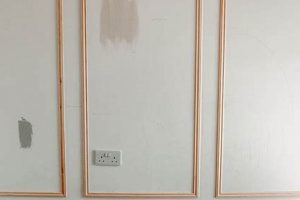A structure constructed from timber to hold back soil or earth is a common landscaping solution. These structures prevent erosion, create level terraces in sloped yards, and define garden beds. Their construction by homeowners, rather than professional contractors, offers a potentially cost-effective approach to landscape management.
The use of these structures provides several benefits, including improved drainage in some applications and enhanced aesthetic appeal. Historically, timber has been a readily available and relatively inexpensive material, making it a practical choice for earth retention projects. This method allows for customization to fit specific site conditions and design preferences.
The subsequent sections will detail design considerations, material selection, construction techniques, and essential safety precautions for building a timber-based earth retaining system. Proper planning and execution are essential to ensure structural integrity and longevity.
Key Considerations for Timber Earth Retention Systems
Effective design and construction of timber earth retention solutions require careful attention to several critical aspects. The following guidelines promote structural integrity and long-term performance.
Tip 1: Site Assessment: Before commencing any construction, conduct a thorough site evaluation. This includes determining soil type, slope grade, potential water runoff patterns, and any existing underground utilities. This assessment informs design and material selection.
Tip 2: Proper Drainage: Adequate drainage is paramount. Install a gravel backfill behind the structure and incorporate weep holes at regular intervals to alleviate hydrostatic pressure. Failure to address drainage can lead to premature failure of the structure.
Tip 3: Material Selection: Opt for pressure-treated lumber specifically designed for ground contact. Select lumber with a high resistance to rot and insect infestation. Consider the expected lifespan of the structure when choosing material grade.
Tip 4: Embedment Depth: Ensure sufficient embedment depth of the bottom course of timbers. A general rule of thumb is to bury at least one-tenth of the total wall height. Consult local building codes for specific requirements based on soil conditions and wall height.
Tip 5: Secure Connections: Utilize heavy-duty fasteners, such as galvanized or stainless steel screws or bolts, to connect timbers. Stagger joints and overlap timbers to distribute load effectively. Avoid using nails, as they provide insufficient holding power in these applications.
Tip 6: Backfilling and Compaction: Backfill in layers, compacting each layer thoroughly. This prevents settling and ensures proper soil support. Avoid using heavy machinery close to the structure to prevent damage during the backfilling process.
Tip 7: Regular Inspection: Implement a routine inspection schedule to identify any signs of deterioration or structural weakness. Address any issues promptly to prevent further damage and ensure the long-term stability of the system.
Adhering to these guidelines ensures a structurally sound and durable timber earth retention system, providing both functional benefits and aesthetic enhancement to the landscape.
The subsequent section will address common problems and troubleshooting techniques associated with timber earth retention systems.
1. Wood Selection
Wood selection is a foundational element in the construction of any timber retaining structure. The choice of wood directly impacts the structural integrity, longevity, and overall performance of the wall. Improper selection can lead to premature failure, increased maintenance costs, and potential safety hazards.
- Species and Natural Durability
Different wood species possess varying degrees of natural resistance to decay and insect infestation. Species such as redwood, cedar, and black locust exhibit inherent durability due to the presence of natural extractives. Utilizing these species, though potentially more expensive initially, can reduce the need for chemical treatments and extend the lifespan of the structure. However, reliance solely on natural durability may still not provide sufficient protection in high-moisture environments.
- Pressure Treatment Options
Pressure-treated lumber undergoes a process where preservatives are forced into the wood cells under pressure, providing enhanced resistance to rot, fungi, and insect damage. Common preservatives include alkaline copper quaternary (ACQ) and micronized copper azole (MCA). The appropriate level of treatment should be selected based on the intended use and environmental conditions. Lumber designated for ground contact (UC4A) is essential for retaining wall applications.
- Dimensional Stability and Warping
The tendency of wood to warp, twist, or shrink as moisture content changes can significantly affect the stability of a retaining wall. Species with lower shrinkage rates, such as redwood and cedar, are preferred for minimizing these effects. Proper drying and seasoning of lumber before construction is crucial to reduce dimensional instability and prevent structural deformation over time.
- Cost and Availability
The cost and availability of different wood species and treatment options can influence the feasibility of a project. While naturally durable species or premium pressure-treated lumber may offer superior performance, they may also be significantly more expensive or difficult to source. Balancing cost considerations with long-term performance requirements is a critical aspect of wood selection.
In conclusion, careful consideration of species durability, pressure treatment options, dimensional stability, and cost factors is paramount for successful implementation. The correct selection will contribute significantly to the structural integrity, longevity, and overall effectiveness of the retaining structure. Failure to consider these factors will often lead to premature failure and increased maintenance costs.
2. Drainage Imperative
Effective water management is crucial to the long-term stability of a timber retaining structure. Water accumulation behind the wall generates hydrostatic pressure, which can compromise the structure’s integrity and lead to premature failure. Therefore, adequate drainage implementation is not merely a best practice but a fundamental requirement.
- Gravel Backfill
A layer of gravel, typically 12 inches or more in width, placed directly behind the structure provides a highly permeable zone for water to flow through. This minimizes the buildup of hydrostatic pressure by allowing water to drain away from the timber. Crushed rock or gravel with a diameter between 0.5 and 1.5 inches is recommended for optimal drainage. The absence of gravel backfill can result in soil saturation and increased lateral pressure against the wall.
- Weep Holes
Weep holes are small openings, typically 2 to 4 inches in diameter, installed at regular intervals along the base of the wall. These holes allow accumulated water to escape, further reducing hydrostatic pressure. Weep holes should be spaced approximately 4 to 8 feet apart, depending on soil conditions and rainfall patterns. Blockage of weep holes by soil or debris can impede drainage and increase the risk of structural failure.
- Drainage Fabric
Geotextile fabric, also known as filter fabric, is a porous material placed between the soil and the gravel backfill. This fabric prevents soil particles from migrating into the gravel and clogging the drainage system. Proper installation of drainage fabric is essential for maintaining the long-term effectiveness of the drainage system. Without it, the gravel backfill can become contaminated with soil, reducing its permeability and hindering water flow.
- Surface Water Diversion
Managing surface water runoff is critical to prevent excessive water from saturating the soil behind the wall. This can be achieved through grading the land to direct water away from the structure, installing gutters to collect rainwater, or creating swales to channel surface runoff. Effective surface water diversion minimizes the amount of water that needs to be managed by the subsurface drainage system, reducing the overall stress on the structure.
The integration of these drainage techniques, each playing a specific role in water management, ensures the lasting integrity of the timber retaining structure. Their combined effect significantly reduces the risk of hydrostatic pressure-related failure, exemplifying why prioritizing drainage is non-negotiable.
3. Structural Support
Structural support constitutes the load-bearing framework of any timber retaining structure, directly influencing its ability to withstand lateral earth pressure. Inadequate structural support is a primary cause of retaining wall failure, making it a critical design and construction consideration.
- Post Embedment and Spacing
The depth to which vertical posts are embedded in the ground and their horizontal spacing are crucial factors. Deeper embedment increases resistance to overturning forces. Closer post spacing reduces the bending moment on the horizontal timbers. Post spacing and embedment depth must be calculated based on soil type, wall height, and anticipated surcharge loads. Engineering calculations are recommended for walls exceeding 4 feet in height. Failure to adequately size and space posts results in wall instability and potential collapse.
- Horizontal Timber Size and Grade
The dimensions and grade of the horizontal timbers that span between the vertical posts determine their ability to resist bending forces. Larger timbers and higher-grade lumber possess greater load-bearing capacity. Timber size must be selected based on the post spacing and the lateral earth pressure acting on the wall. Using undersized or low-grade lumber can lead to excessive deflection, cracking, and eventual failure of the timbers.
- Connection Details
The manner in which the horizontal timbers are connected to the vertical posts significantly affects the overall structural integrity of the wall. Secure connections transfer loads effectively and prevent separation of the structural elements. Appropriate fasteners, such as galvanized lag screws or through bolts, must be used. The use of nails or undersized fasteners is inadequate for retaining wall applications. Improper connection details can result in joint failure and structural instability.
- Backfill Material and Compaction
The type of backfill material used behind the wall and the degree to which it is compacted influence the lateral earth pressure acting on the structure. Well-draining granular materials, such as gravel or crushed stone, reduce hydrostatic pressure and minimize lateral loads. Proper compaction of the backfill material increases its shear strength and reduces settling. Poorly draining backfill material and inadequate compaction can significantly increase lateral earth pressure and compromise the stability of the wall.
These structural elements, acting in concert, provide the necessary resistance to lateral earth pressure. Their careful design and construction, incorporating appropriate materials and techniques, are essential for ensuring the long-term stability and functionality of any timber retaining structure.
4. Proper Assembly
The success of a homeowner-constructed timber retaining structure hinges critically on proper assembly techniques. This phase transcends merely fitting pieces together; it embodies the precise execution of design specifications to guarantee structural integrity and long-term performance. Incorrect assembly introduces vulnerabilities that compromise the wall’s capacity to withstand soil pressure, ultimately leading to premature failure and potential property damage. For instance, inadequate overlapping of timbers or the omission of appropriate fasteners can create weak points susceptible to separation under stress. Real-world examples abound of walls failing due to improper joint construction, highlighting the practical significance of meticulous assembly practices.
Specifically, proper assembly involves several interconnected aspects. Staggering joints between courses distributes load effectively, preventing concentrated stress points. Using appropriate fasteners, such as galvanized lag screws or through bolts, ensures secure connections between timbers and posts. Pre-drilling pilot holes mitigates wood splitting during fastener installation, maintaining the integrity of the timber. Furthermore, ensuring correct alignment and leveling during the assembly process is crucial for uniform load distribution and preventing localized stress concentrations. Deviations from these practices, however small, can accumulate and significantly reduce the wall’s overall strength.
Therefore, an understanding of proper assembly principles is paramount for any individual undertaking a timber retaining structure project. While design and material selection are undoubtedly important, the actual construction phase dictates the wall’s real-world performance. Addressing challenges such as working with heavy timbers or ensuring accurate alignment requires careful planning and execution. Ultimately, the durability and effectiveness of a homeowner-constructed retaining wall depend significantly on meticulous adherence to proper assembly techniques, underscoring its vital role within the project.
5. Soil Compaction
Soil compaction is an indispensable consideration in the construction of timber retaining structures. The degree of soil compaction directly influences the stability of the wall, its ability to withstand lateral earth pressure, and its overall lifespan. Inadequate compaction can lead to settling, instability, and premature failure.
- Reduction of Settling
Proper soil compaction minimizes the potential for settling behind the retaining structure. Uncompacted soil contains significant air voids that gradually collapse over time under the weight of the soil itself and any surcharge loads. This settling can create voids behind the wall, reducing lateral support and potentially causing the wall to lean or collapse. Consistent compaction in layers effectively reduces these air voids, limiting settling and maintaining stable support. Instances of retaining wall failure often trace back to insufficient compaction during backfilling operations.
- Increased Shear Strength
Compacted soil exhibits increased shear strength, meaning it is better able to resist lateral forces. The more tightly packed soil particles interlock, the greater the resistance to slippage and deformation. This increased shear strength directly translates to enhanced resistance against the lateral earth pressure exerted on the retaining wall. Backfill material with low shear strength due to inadequate compaction is more likely to deform and place excessive stress on the wall, accelerating its deterioration.
- Enhanced Drainage
While seemingly counterintuitive, controlled compaction can improve drainage characteristics in some soil types. By creating a more uniform and stable soil structure, compaction can prevent the formation of preferential flow paths and promote more even distribution of water. This can reduce the likelihood of localized saturation behind the wall, which can lead to increased hydrostatic pressure. However, it’s crucial to avoid over-compaction, which can impede drainage in clay-rich soils. The ideal level of compaction should balance stability with effective water management.
- Mitigation of Frost Heave
In regions subject to freezing temperatures, soil compaction can help mitigate frost heave. Frost heave occurs when water within the soil freezes and expands, exerting significant upward pressure on structures. Compacted soil has fewer large voids where water can accumulate and freeze, reducing the potential for frost heave. While compaction alone cannot eliminate frost heave entirely, it can significantly reduce its impact on a timber retaining structure.
In conclusion, effective soil compaction is not merely a supplementary step but a fundamental aspect of timber retaining structure construction. Its impact on settling reduction, shear strength enhancement, drainage optimization, and frost heave mitigation underscores its critical role in ensuring the long-term stability and functionality of these structures. Ignoring or underestimating the importance of soil compaction will typically result in costly repairs or complete wall failure.
6. Embedment Depth
The depth to which a timber retaining structure is embedded below the ground surface is a critical determinant of its stability and resistance to overturning forces. Insufficient embedment depth is a common cause of failure, particularly in DIY wood retaining wall projects where adherence to engineering principles may be lacking.
- Resistance to Overturning
Embedment depth provides passive soil resistance against the toe of the wall, counteracting the overturning moment created by lateral earth pressure. The deeper the embedment, the greater the resisting force. As a rule of thumb, a minimum embedment depth of one-tenth of the total wall height is often recommended, but this can vary depending on soil type and loading conditions. Inadequate embedment leaves the wall susceptible to tipping forward, especially under saturated soil conditions or when subjected to surcharge loads.
- Anchoring Against Sliding
In addition to resisting overturning, embedment depth also contributes to the wall’s resistance to sliding. The embedded portion of the wall acts as a key, preventing the structure from sliding horizontally along the ground surface. This is particularly important in sloping terrain where the downslope component of the soil weight can exacerbate sliding forces. A lack of sufficient embedment can allow the entire wall to shift horizontally over time, compromising its structural integrity.
- Influence of Soil Type
The required embedment depth is directly influenced by the type of soil in which the wall is constructed. Walls built in loose, sandy soils require deeper embedment than those built in dense, cohesive soils. Sandy soils offer less resistance to overturning and sliding, necessitating increased embedment to compensate. Conversely, clay soils provide greater passive resistance, potentially allowing for shallower embedment depths. However, clay soils also tend to retain more water, increasing lateral earth pressure, so this must be factored into the design.
- Impact of Wall Height
As the height of the retaining wall increases, so does the lateral earth pressure acting upon it. This increased pressure necessitates a corresponding increase in embedment depth to maintain stability. Taller walls are subject to greater overturning and sliding forces, requiring a more robust foundation to counteract these effects. Therefore, the relationship between wall height and embedment depth is critical, and must be carefully considered during the design phase.
The proper calculation and execution of embedment depth are vital for ensuring the stability and longevity of any timber retaining structure, especially those constructed by homeowners. Ignoring or underestimating the importance of embedment can lead to costly repairs or complete structural failure, emphasizing the need for careful planning and adherence to established engineering guidelines.
7. Preservation Treatment
Preservation treatment is a crucial component for any timber retaining structure, particularly when constructed as a DIY project. Wood, being an organic material, is susceptible to degradation from moisture, insects, and fungal decay. Without appropriate preservation, a timber structure’s lifespan is significantly reduced, leading to potential structural failure and costly repairs. The impact of inadequate treatment is evidenced in numerous cases where untreated or improperly treated timber walls succumb to rot within a few years of construction.
The selection of preservation treatment method is critical. Pressure treatment, involving the forced impregnation of preservatives into the wood, is generally considered the most effective method for structures in ground contact. Alternatives include surface applications of preservatives; however, these provide less protection and require periodic reapplication. Proper application is also paramount; inadequate coverage or penetration leaves the wood vulnerable. Examples of effective preservation include the use of ACQ (Alkaline Copper Quaternary) treated lumber, which resists a broad spectrum of decay organisms and insects, widely used for landscape timbers.
Understanding the significance of preservation treatment empowers DIYers to make informed decisions regarding material selection and construction techniques. While cost considerations may be a factor, the long-term benefits of investing in properly treated timber far outweigh the initial savings of using untreated materials. The practical significance of this understanding lies in the ability to construct durable, long-lasting retaining walls that contribute to property value and landscape stability, while minimizing the risk of premature failure and associated expenses.
Frequently Asked Questions
The following section addresses common inquiries regarding the planning, construction, and maintenance of timber-based earth retention structures. The information aims to provide clarity and guidance for those undertaking such projects.
Question 1: What is the expected lifespan of a timber retaining structure?
The lifespan of a timber earth retention structure varies significantly based on several factors, including the type of wood used, the effectiveness of preservation treatments, drainage conditions, and the severity of environmental exposure. Properly constructed walls utilizing pressure-treated lumber and incorporating adequate drainage can reasonably be expected to last 20 to 30 years or more. However, untreated timber in direct contact with soil may only last a few years.
Question 2: Is a building permit required for constructing a timber retaining structure?
Permitting requirements vary depending on local building codes and the height of the retaining structure. Many jurisdictions require permits for walls exceeding a certain height, typically 3 or 4 feet. It is essential to consult with local building officials to determine specific permit requirements before commencing construction. Failure to obtain necessary permits can result in fines and the requirement to remove the structure.
Question 3: What type of wood is best suited for use in a timber retaining structure?
Pressure-treated lumber specifically designed for ground contact (UC4A rating) is generally the best choice. This type of lumber has been treated with preservatives to resist rot, fungi, and insect infestation. While naturally durable wood species, such as redwood or cedar, can be used, they are typically more expensive and may not provide the same level of long-term protection as pressure-treated lumber.
Question 4: How critical is drainage in a timber retaining structure?
Adequate drainage is paramount for the long-term stability of a timber earth retention structure. Water accumulation behind the wall generates hydrostatic pressure, which can compromise the structure’s integrity and lead to premature failure. Proper drainage involves installing a gravel backfill, incorporating weep holes, and utilizing geotextile fabric to prevent soil clogging.
Question 5: Can a timber retaining structure be built on a slope?
Yes, timber earth retention structures can be built on slopes, but it is essential to address the additional challenges posed by sloping terrain. This may involve terracing the slope, increasing the embedment depth of the wall, and providing additional drainage to manage surface water runoff. A thorough site assessment and careful design are crucial for ensuring stability on sloping ground.
Question 6: What are the signs of a failing timber retaining structure?
Signs of a failing timber earth retention structure can include leaning or bowing of the wall, bulging or cracking of the timbers, water accumulation behind the wall, and soil erosion at the base of the wall. If any of these signs are observed, it is essential to consult with a qualified engineer or contractor to assess the situation and determine appropriate remedial measures. Addressing problems early can prevent further damage and potential collapse.
The information provided in this FAQ section is intended for general guidance only and should not be considered a substitute for professional engineering advice. Consult with qualified professionals for specific design and construction recommendations.
The subsequent section will explore the environmental impact associated with the construction of timber retaining structures.
DIY Wood Retaining Wall
This exploration has underscored the multifaceted nature of the task. From material selection and drainage implementation to structural support and proper assembly, each element demands meticulous attention. The long-term stability and functionality of any structure depend on diligent adherence to established principles and best practices. Neglecting any of these key considerations invariably increases the risk of premature failure and subsequent economic burden.
Therefore, embarking on a structure construction necessitates thorough preparation and a commitment to excellence. While the allure of cost savings may be strong, compromising on quality or expertise is ultimately self-defeating. Only through careful planning and rigorous execution can the potential benefits be fully realized, resulting in a stable, aesthetically pleasing, and enduring landscape feature.







